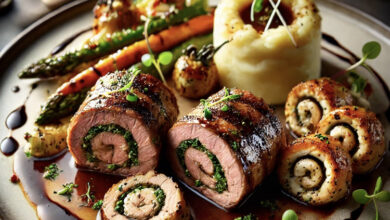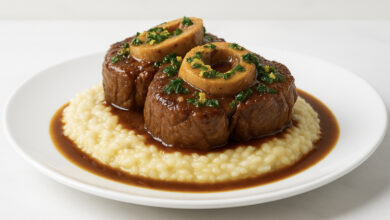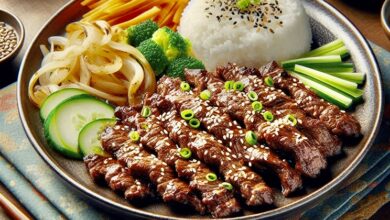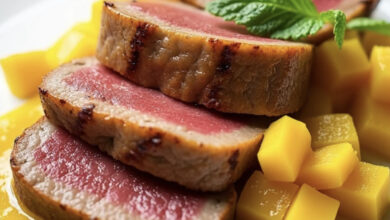Pappardelle with Bolognese: The Perfect Comfort Food
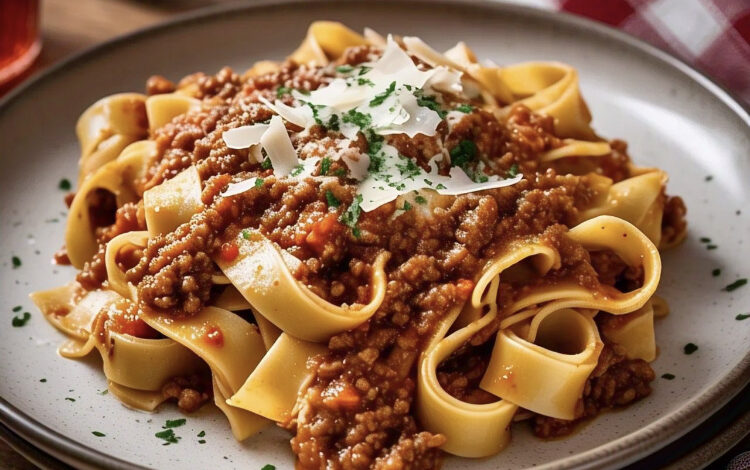
Few dishes capture the essence of Italian comfort cooking quite like Pappardelle with Bolognese. Imagine wide, ribbon-like noodles coated in a hearty meat sauce that’s been simmered to perfection. In the accompanying photo, you can almost see each strand of pappardelle glistening under a generous layer of rich Bolognese, sprinkled with freshly grated Parmesan and a touch of parsley. It’s a visual invitation to indulge in a timeless Italian classic—one that merges simplicity with robust, unforgettable flavor.
A Brief Introduction to Pappardelle with Bolognese
Pappardelle, a wide and flat pasta traditionally made with eggs and flour, is tailor-made for thick, meaty sauces. Its broad surface area and ridged edges are perfect for holding onto every drop of that savory Bolognese. Originating in the Emilia-Romagna region of Italy—often considered the culinary heart of the country—Bolognese sauce is a slow-cooked ragù that emphasizes the quality of each ingredient. From the sweetness of diced carrots and onions to the rich depth of ground beef, every element plays a crucial role in creating a sauce that’s both complex and comforting.
This dish embodies the warmth of family gatherings and the joy of sharing a homemade meal. Whether you’re preparing it for a cozy dinner at home or looking to impress guests with a true Italian classic, Pappardelle with Bolognese never fails to delight.
Why Pappardelle is Ideal for Bolognese
When you look at the photo of this dish, one detail stands out: the broad, ribbon-like noodles. Unlike spaghetti or penne, pappardelle has the perfect shape to scoop up plenty of meat sauce in every forkful. Its wide surface area ensures the flavors of the tomatoes, beef, and herbs meld seamlessly with the pasta. This pairing is so harmonious that many Italian cooks consider pappardelle the go-to pasta for hearty sauces like Bolognese.
Key Ingredients for a Robust Bolognese Sauce
The beauty of this recipe lies in its simplicity and the quality of each ingredient. Here’s a closer look at what you’ll need:
- Olive Oil (2 to 3 tablespoons)
- Serves as the flavorful foundation for sautéing vegetables and browning the beef.
- Extra-virgin olive oil offers a fruity note, while regular olive oil provides a more neutral backdrop.
- Onion (1 medium, diced)
- White or yellow onion works well; each brings a slightly different flavor.
- Onions form the aromatic base, lending sweetness and depth to the sauce.
- Carrot (1 medium, diced)
- Adds a subtle sweetness that balances the acidity of the tomatoes.
- Dicing it finely helps it blend seamlessly into the sauce.
- Celery (1 rib, diced)
- Contributes an herbal undertone and a bit of texture.
- Essential for that classic mirepoix trio alongside onion and carrot.
- Garlic (2 cloves, minced)
- Infuses a gentle pungency, elevating the overall flavor profile.
- Freshly minced garlic is preferred for its bright, aromatic quality.
- Ground Beef Chuck (1 pound)
- Offers a rich, beefy taste and a slightly higher fat content for a more flavorful sauce.
- The marbling in chuck ensures a tender, juicy result.
- Salt and Freshly Ground Black Pepper
- Enhances and balances all other flavors.
- Season gradually and taste as you go.
- Crushed or Diced Tomatoes (1 can, 28 ounces)
- Forms the sauce base.
- High-quality canned tomatoes add a robust, slightly sweet tomato flavor.
- Parsley (1/4 cup, chopped)
- Brings a fresh, bright note that complements the richness of the sauce.
- Stirred in at the end or used as a garnish for extra color and flavor.
- Fresh Basil Leaves (6 to 8, chopped)
- Adds a signature Italian aroma and a gentle sweetness.
- Best added in the final stages of cooking to preserve its fragrance.
- Pappardelle Noodles (1 pound)
- Wide, ribbon-like pasta that pairs perfectly with thick sauces.
- Look for fresh or dried versions labeled “pappardelle.”
- Parmesan Cheese (1/4 cup freshly grated, plus more for serving)
- Lends a salty, nutty finish that ties all flavors together.
- Freshly grated cheese melts more evenly and tastes better than pre-shredded varieties.
Step-by-Step Instructions for the Perfect Pappardelle with Bolognese
1. Gather Your Equipment
- Large stockpot or Dutch oven for making the sauce
- Heavy-bottomed skillet (if preferred) for browning the beef
- Large pot for boiling the pasta
- Wooden spoon for stirring
- Sharp knife and cutting board for prepping vegetables
2. Sauté the Vegetables
- Warm the Olive Oil:
- Heat 2 to 3 tablespoons of olive oil in a large stockpot or Dutch oven over medium-high heat.
- Add Onion, Carrot, and Celery:
- Stir the diced onion, carrot, and celery into the hot oil.
- Cook for 5 to 7 minutes, or until the vegetables soften and the onion becomes translucent.
- Incorporate the Garlic:
- Add the minced garlic and cook for an additional minute.
- Keep a close eye to prevent the garlic from burning.
3. Brown the Ground Beef
- Add the Beef:
- Crumble the ground beef chuck into the pot.
- Season lightly with salt and freshly ground black pepper.
- Break Up Clumps:
- Use a wooden spoon to break the beef into small pieces as it cooks.
- Brown the meat for 5 to 8 minutes, or until no pink remains.
- Drain Excess Fat (If Needed):
- If the beef releases a lot of fat, carefully spoon off the excess.
- A bit of fat can enhance flavor, but too much will make the sauce greasy.
4. Build the Sauce
- Add the Tomatoes:
- Stir in the 28-ounce can of crushed or diced tomatoes.
- If you prefer a smoother sauce, use crushed tomatoes; for a chunkier texture, choose diced.
- Season and Simmer:
- Add another pinch of salt and pepper.
- Reduce the heat to low and let the sauce simmer for 20 to 30 minutes.
- This simmering process melds the flavors and slightly thickens the sauce.
- Stir in Herbs:
- Gently fold in the chopped parsley and basil leaves.
- Continue simmering for an additional 5 minutes to let the herbs release their aroma.
5. Cook the Pappardelle
- Boil Water:
- Fill a large pot with water and bring it to a rolling boil.
- Add a generous pinch of salt to season the water.
- Add Pappardelle:
- Gently place the pappardelle noodles into the boiling water.
- Cook according to the package instructions, typically 7 to 9 minutes, or until al dente.
- Drain and Reserve:
- Drain the pasta, reserving about 1/2 cup of the pasta water.
- The starchy water can help loosen the sauce if it’s too thick.
6. Combine and Serve
- Toss the Pasta in Sauce:
- Transfer the cooked pappardelle to the pot containing the Bolognese sauce.
- Gently stir until each ribbon is coated with the sauce.
- If needed, add a splash of the reserved pasta water to achieve the desired consistency.
- Finish with Parmesan:
- Sprinkle 1/4 cup of freshly grated Parmesan cheese over the pasta and sauce.
- Toss to combine, allowing the cheese to melt into the sauce.
- Plate and Garnish:
- Serve hot, topping each plate with an extra sprinkle of Parmesan.
- For a final touch, add a dash of fresh parsley or basil on top.
Tips and Tricks for an Exceptional Dish
- Quality Ingredients:
High-quality olive oil, fresh herbs, and good canned tomatoes make a noticeable difference in flavor. - Meat Options:
While ground beef chuck is traditional, you can experiment with ground pork, veal, or a blend of meats for a richer taste. - Slow Simmer:
If time allows, simmer the sauce longer—up to an hour or more. A longer cook time deepens the flavors. - Season Gradually:
Add salt in stages. This approach helps you control the overall sodium level and ensures balanced seasoning. - Storing Leftovers:
Refrigerate leftover Bolognese sauce in an airtight container for up to three days. Reheat gently on the stove, adding a bit of water or broth to maintain consistency. - Freezing Sauce:
The Bolognese sauce (without the pasta) freezes exceptionally well. Store in freezer-safe containers for up to three months. Thaw overnight in the refrigerator before reheating.
Serving Suggestions
- Classic Pairing:
Serve this Pappardelle with Bolognese alongside a crisp green salad dressed with olive oil and balsamic vinegar. - Wine Match:
A medium-bodied red wine like Sangiovese or Chianti perfectly complements the savory richness of the sauce. - Side Dishes:
Warm garlic bread or focaccia is a great way to soak up any leftover sauce on your plate. - For the Crowd:
Hosting a dinner party? Double the recipe, prepare the sauce ahead, and simply cook the pasta right before mealtime.
The Picture-Perfect Plate
If you look closely at the photo, you’ll notice the sauce clinging to each pappardelle ribbon. The bright orange-red hue of the tomatoes contrasts beautifully with the specks of green herbs. A light dusting of grated Parmesan crowns the dish, hinting at the cheesy depth you’ll discover in every bite. This visual appeal mirrors the taste: bold, hearty, and comforting.
A Dish Rooted in Tradition
Pappardelle with Bolognese is more than just a meal—it’s a culinary tradition that has endured for generations. In many Italian households, the process of preparing Bolognese sauce starts early in the day, allowing the flavors to marry slowly as the sauce simmers on the stove. Grandmothers pass down their secret tips—like adding a splash of red wine or a hint of sugar to cut the tomatoes’ acidity. Over time, each family develops its own unique spin on this classic recipe, making it both personal and universal.
Conclusion: Savor Every Bite
Whether you’re an experienced cook or just beginning your culinary journey, Pappardelle with Bolognese offers a rewarding, soul-warming experience. The key is patience: allow the sauce to simmer, the flavors to meld, and the pasta to absorb the richness of the ragù. With each forkful, you’ll taste the harmony of quality ingredients and time-honored cooking methods.
So roll up your sleeves, gather your ingredients, and prepare to indulge in a dish that effortlessly combines rustic charm with refined taste. Your kitchen will fill with the aroma of simmering tomatoes, garlic, and fresh herbs, creating an inviting ambiance for family and friends. One bite, and you’ll understand why this Italian classic has earned a place in hearts—and on tables—around the world.
Enjoy your homemade Pappardelle with Bolognese, and don’t forget to top it off with an extra sprinkle of Parmesan. After all, there’s no such thing as too much cheese when it comes to Italian comfort food. Buon appetito!

